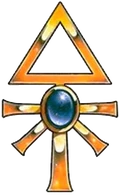| Eldar (Aeldari) Empire | |
| Head of State: | Unknown |
| Capital: | Crone Worlds now in the Eye of Terror |
| Official languages: | Eldar Lexicon |
| Governing body: | Unknown; included the first Haemonculi |
| State Religions: | Eldar Mythology |
| Major Species: | Aeldari (Eldar) |
| Military Forces Unknown | |
The Eldar Empire, also called the Aeldari Empire, was the great interstellar empire of the Eldar species, who were known instead as the "Aeldari" at its height. The Eldar Empire was the dominant power of the Milky Way Galaxy in the years after the end of the War in Heaven until the Fall of the Eldar in the 30th Millennium A.D. The Eldar Empire held almost complete control over the galaxy, even during Mankind's Age of Technology, and was characterised by both its own highly advanced technology and the increasingly cruel and hedonistic excesses of its people in its final years. It was this excess that ultimately brought about the empire's destruction when its people's psychic resonance in the Immaterium birthed "She Who Thirsts," the Chaos God of Pleasure, Slaanesh. Slaanesh's birth was a catastrophic event that consumed the heart of the Eldar Empire's homeworlds within the newborn Warp rift called the Eye of Terror, as the Prince of Pleasure sought to absorb every Eldar soul.
Some survivors of the catastrophe fled the empire's core worlds in their massive, continent-sized voidcraft called Craftworlds, creating the Infinity Circuits and pursuing the Eldar Paths to safeguard their life essence from Slaanesh's thirst -- even after death. Other survivors, the hedonistic adherents of the Aeldari pleasure cults who had been protected from She Who Thirsts by settling within the interdimensional framework of the Webway, became the Dark Eldar of Commorragh. Among this group of survivors were many members of the empire's leadership, who would become the first of the Dark Eldar Haemonculi. Other Aeldari survivors included the Harlequins, the servants of Cegorach, the Laughing God, who roamed the far reaches of the Webway and moved between Commorragh and the Craftworlds at will. The final group were the Exodites, Eldar who, like their Craftworld brethren, had fled the excesses of the empire's heart, surrendered much of their advanced technology and lived peaceful, largely pastoral lives on the Maiden Worlds. All of these survivors surrendered the term "Aeldari" as a name for their species, casting it off as a reminder of their lost glory. Instead, they became the Eldar, and their empire is now little more than a forgotten dream.
History
Millions of Terran years ago, as the galaxy emerged from the defeat of the Necrons in the War in Heaven and the disappearance or extinction of the Old Ones, their creations, the Aeldari, emerged as the new masters of the galaxy. The technological prowess of the Aeldari soon eclipsed that of all the other civilisations of the galaxy, and they pushed the existing menaces of the time, such as the Orks, to the far fringes of their realm. The Aeldari became increasingly arrogant and condescending towards other intelligent species. Their empire spread across the galaxy, eventually encompassing at least 10,000 star systems and thousands more colonised planets, many concentrated in the region of the galaxy that would one day become the Eye of Terror. At this time, when an Aeldari died, his soul peacefully became one with the Warp, later to be reborn once more and begin the cycle anew. The Immaterium had not yet become the hostile place it is now, and some of its most powerful denizens were the Gods of the Eldar.
The Golden Age
Over a million standard years ago, the Aeldari alone ruled the stars as the undisputed masters of their own destiny. Such a position was their right, they thought, and their preeminence was beyond doubt. In many ways, the Aeldari had good reason for such hubris, for no other sentient race of the galaxy had posed a serious threat to their wealth and stability for time immemorial after the fall of the Necron. They were convinced that they no longer had anything to fear from the galaxy at large, and they may have been right, but the real danger came from within. The doom of the Aeldari, when it came, took a form far more subtle and dangerous than that of alien invasion. At that point in Aeldari history, nothing was beyond their reach and nothing was forbidden. The ancient race continued their glorious existence unaware or unwilling to acknowledge the dark fate that awaited them. They plied the stars at will, experiencing the wonders of the galaxy and immersing themselves completely in the endless sensations that it offered them. Such was the technological mastery of the Eldar that worlds were created specifically for their pleasure, and stars lived or died at their whim.
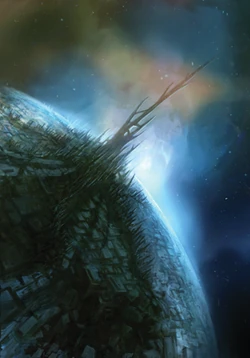
A satellite realm of Commorragh within the Webway
On hundreds of idyllic planets seeded across the stars, the Eldar pursued their inclinations as they willed, indulging every dream and investigating every curiosity. They mastered the Labyrinth Dimension of the Webway, expanded their realms into the furthest corners of reality and learned much about the universe that has since been forgotten. They moved whole stars into the Webway, creating vast new cities hidden within the seams behind reality. Commorragh was originally the greatest of these Webway portal-cities before the Fall and was intended to be used to transport a fleet to any of the homeworlds of the Eldar Empire. Because of the access it could grant to even the most far-flung corners of the galaxy in realspace, Commorragh was held by the ancient Aeldari to be the most important location within the entire Webway. Because of this intrinsic strategic value, it was not controlled by any of the dominant factions within the Eldar Empire. Precisely because of its autonomy from the jurisdiction of the great Eldar councils that governed the empire, the city-port soon became a magnet for all those inhabitants of the Eldar civilisation who wished to hide from prying eyes. The realm of Commorragh rapidly expanded as all the wealth and influence of the great Eldar empire and its allies flowed into its coffers. It spread outward into the Webway's void, consuming the other port-cities, private estates and satellite realms of the Labyrinthine Dimension, growing ever larger and even more impressive off the plunder of ten thousand worlds.
When Aeldari spirits eventually left their mortal bodies they dissolved peacefully back into the aether to be reborn again, for the Warp did not thirst for Eldar souls then as it does today. There were, of course, many wars. Even when the galaxy was young there were upstart races seeking to gouge out petty star empires of their own, and the Eldar waged wars that ravaged dozens of star systems and cost trillions of lives. Most of these conflicts, though, were so short-lived that the ease of their victory left the Eldar ever more sure of their ascendancy. Even the greatest of all their own conflicts, known in the mythic cycles of the Craftworlds as the War in Heaven, did not humble them. In their hearts the Eldar reigned supreme, and no other power could end their dominance.
Descent into Decadence
To understand the reasons for what savants name the Fall of the Eldar, it is necessary to know something of the Eldar mind and soul. An Eldar's mind is incredibly complex. Their senses are extremely sharp, able to perceive incredible levels of detail. Their emotions can be so strong that a human's are merely pale shadows by comparison. They are extremely intelligent; their thought processes are much faster than a human's. All of this means that an Eldar experiences the universe and all its sensations to a greatly heightened degree compared to a human. Similarly, an Eldar's soul is much brighter in the Warp than those of "lesser" sentients like humans who do not possess such potent psychic abilities. Eldar are able to affect the nether-realm of the Warp much more than most other intelligent races. Every Eldar is a latent psychic and has the ability to become a very powerful psyker with training. It is the psychic strength of the Eldar's souls that was one of the primary causes of their downfall.
The catalyst that brought about the Eldar race's fall came from the very depths of the Eldar's collective psyche, the innate need to fuel their passions and indulge in every extreme. The Aeldari had long outgrown the need for labour or manual agriculture. Society provided all that was required without individual effort, leaving long Terran centuries for the Aeldari to spend sating their every desire. Life on the Aeldari homeworlds was idyllic, with fantastically sophisticated machines that took care of all the labour and manufacturing required to keep an advanced society functioning, leaving the Aeldari free to indulge in other, more aesthetic pursuits. With all menial work taken care of for them, the Aeldari became indolent and decadent. Fuelled by an inexhaustible curiosity, many gave way to their most hedonistic impulses. Exotic cults sprang up across the Aeldari domains that eclipsed the noble pursuits of old, each dedicated to esoteric knowledge or sensual excess. The core of the Aeldari race began to look inwards, inexorably seeking new ways to explore the full range of emotion and sensation. With no need to perform substantial work or labour, the Aeldari began to pursue their curiosities and desires with all the dedication that only their species could muster. This descent into decadence spanned many Terran millennia. Tradition and order disintegrated as the Eldar pursued the limits of the pursuit of pleasure. In the later days of Aeldari civilisation, Pleasure Cults devoted to exotic knowledge, physical pleasures, and ever-more outrageous forms of entertainment sprang up. It did not take long for many of the Aeldari to pursue a darker path to achieve instant fulfillment as they came to revel in unbridled hedonism and violence. Such behaviour was perilously decadent and, in the end, corrosive to the soul of the race. The pursuit of excess gradually became a blight upon the whole society.
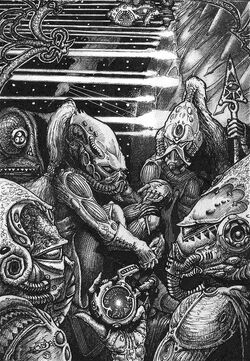
Ancient Eldar lead their people aboard the Craftworlds to salvation before the Fall of the Eldar
Many of the Aeldari grew uneasy with the actions of their comrades, and the wisest of the Seers warned that this path could lead only to evil and suffering for the entire species. As the cults gained a tighter hold over their society, the Aeldari became increasingly divided. Those who saw the foulness that corrupted their people for what it was became known as Exodites, fleeing to found colony worlds -- the Maiden Worlds -- on the fringes of the Eldar Empire. As the civilisation slid further into anarchy, others repented of their ways and left the central worlds of their empire to settle in the outlying regions of the galaxy, where they built great worldships called Craftworlds. Other Eldar stayed on the homeworlds to try and alter the path their race had taken. Most continued to glut themselves on the pursuits of the depraved.
Among the pleasure-seekers and the interminably curious of the Aeldari were those whose pursuit of excess became ever more extreme. These included a great proportion of the aristocracy of ancient Aeldari society, who possessed the wealth and time to truly explore the meanings of decadence -- and would one day become the monstrous fleshspaers called the Haemonculi. One by one, the leaders of the Pleasure Cults that were becoming the centrepiece of Aeldari society became obsessed with their own power. They relocated their headquarters to the Labyrinth Dimension of the Webway, for so great was their political influence that they could command the construction of entire extradimensional sub-realms just for themselves. Unseen, these Pleasure Cult lords continued to grow in power and influence, initiating more and more of the ancient Aeldari population into their strange and shadowy creeds of decadence. The Eldar are the most psychically gifted of all sentient beings in the galaxy and as the corruption gradually seduced them, the echoes of their ecstasy and agony began to ripple through time and space. In the parallel dimension of the Immaterium, the Warp, the reflections of these intense experiences began to coalesce, as the shifting tides of the chaotic Empyrean can take form around the raw emotions emitted by the sentient beings of the material universe and attract even more of such similar psychic energies to themselves. The constant stream of individual selfishness and indulgence pouring into the Warp from the Eldar empire slowly and silently nourished and empowered that which lay within -- a nascent God of pleasure and pain, content to wait and to grow.
The heartfelt sorrow of those left who mourned the loss of innocence eventually turned to bitterness and spite. In time, brother fought brother, and sadistic killers stalked the shadows in search of victims for their vile lusts. No life was spared in the pursuit of pleasures both murderous and perverse. A sickness of vice overtook the Aeldari race, and blood flowed through the streets amidst the bestial roar of the crowd. Their hidden realms within the Webway such as Commorragh became sprawling palaces of avarice and sadism, and entire worlds were bent to the pursuit of the darkest of sensations.
As their society collapsed into civilisation-wide insanity, these Aeldari recoiled in horror from what they were becoming. Realising that they stood upon the brink of destruction, they bent their considerable resources to the construction of the massive Craftworlds, the graceful spaceborne cities that were the size of small moons. The Eldar of the Craftworlds retreated into asceticism and spiritual introspection, preserving what they could of their ancient ways and culture before the time of the Pleasure Cults. They left the core worlds of the Eldar Empire behind for the dubious safety of deep space, to the laughter and contempt of those who remained behind. Some even managed to flee far enough to escape the terrible destruction of the coming Fall.
Birth of a Dark God
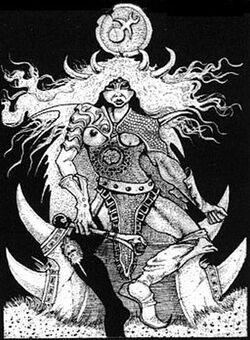
Slaanesh, Dark Prince of Pleasure and Doom of the Eldar
The torture cults eroded the future of the Aeldari as a viable galactic empire. This process lasted for thousands of standard years, corresponding to the historical era that was Mankind's Dark Age of Technology, although when Slaanesh finally came into being the results within the material universe were apocalyptic and sudden. As depravity riddled every aspect of Eldar society, the Pleasure Cults sought ever more violent thrills. Before long the streets of Aeldari cities ran with their blood. The elegant architecture of their palaces became battlegrounds as the Aeldari preyed upon each other, revelling in the cruelest of crimes.
While this debauchery would have been destructive within any society, it was even more damaging for the Aeldari because of their powerful psychic abilities. Within the parallel dimensional realm of the Warp, the psychic emanations of these perverse activities began to gather, strengthened by the souls of departed Aeldari hedonists and cultists. As the Aeldari's vices grew, this dark mass of negative psychic energy did as well, producing the terrible Warp Storms that defined humanity's Age of Strife and made all interstellar travel and communication impossible for the human colonies of this period. What an unimaginably foul and sickening thing it was that the Aeldari unknowingly raised in the Warp; it was a dire shadow of themselves, of what they had become, of nobility and pride brought low by perversity and shamelessness. Worlds burned as the Aeldari slew and laughed and feasted upon the corpses of the dead.
Slowly, the Great Enemy stirred towards wakefulness. Too late, the Aeldari realised that they had created a new god in their own image, a god grown immense and potent by suckling upon the dark fodder of the Aeldari spirit. Eventually, this growing mass of negative psychic energy came into a life of its own and came to consciousness over ten thousand standard years ago at the end of the Age of Strife in the early 30th Millennium as the newborn Chaos God Slaanesh, the Devourer of Souls and the doom of the Aeldari -- and their Eldar successors. When Slaanesh finally burst into divine consciousness, there was not one Eldar alive who did not feel its claws in his or her soul. With a howl of raw power, Slaanesh roared into supernatural life. A psychic implosion tore at the universe. The psychic scream of Slaanesh's birth tore the souls from all the Aeldari within a thousand light years of it, sparing only those sheltered in the Wraithbone hulls of the Craftworlds. Countless billions of Eldar screamed aloud and fell dead. In a heartbeat, the shining Eldar civilisation that had lasted for aeons had its heart ripped out, leaving a pulsing afterbirth of pure chaos in its place. The spirits of the Eldar were drawn from within them and consumed as their blasphemous creation took its first infernal breath. Intoxicated with this draught, Slaanesh laughed and looked upon a universe ripe for the taking.
The Death of an Empire
The epicentre of the psychic apocalypse lay within the gilded heart of the Aeldari realms. All Aeldari within thousands of light years were reduced to lifeless husks, their souls forever claimed. Even those who had foreseen the catastrophe and fled upon the Craftworlds were overwhelmed, with only those furthest from the devastation surviving. The remote Exodite worlds remained largely untouched, but within the space of a single moment, the Aeldari had become a doomed people. Their nemesis was born and would hunt them for the rest of eternity. Though the psychic shockwave focused upon the Aeldari, billions of humans, Orks and creatures from other races were obliterated as well. Warpspace convulsed as a cosmic hurricane raged across the galaxy. The fabric of reality was torn apart and the Warp spilled from the newborn dimensional rift into the material universe, turning hope into despair and paradise into hell. Psykers of all races howled with pain as their people died in storms of blood and madness. The roiling wound in realspace spread outward until it completely encompassed the Aeldari realms of old. This gaping lesion would come to be known as the Eye of Terror; the largest area in the galaxy where the Warp and the material universe overlap until the birth of the Great Rift in 999.M41. Within its reaches daemons bathe in the raw energy of the Warp, whilst Daemon Princes and the worshippers of Chaos rule over Aeldari planets turned into nightmare worlds of fire and darkness.
For ten thousand long Terran years before the Fall, the Warp had been riven with storm and tempest, making it almost impossible for the vessels of the lesser races to travel between the stars. With the birth of Slaanesh, the Warp was becalmed, its rage temporarily spent. A new equilibrium was reached as Slaanesh joined the ranks of the Chaos Gods. With the Warp Storms around ancient Terra dispersed, the Emperor of Mankind was able to launch his Great Crusade. A new power took its place in the galaxy as isolated human worlds from across the stars were united under the same banner. In this way, the Fall of the Eldar heralded the rise of the Imperium, and Mankind inherited the stars.
The Fight For Survival
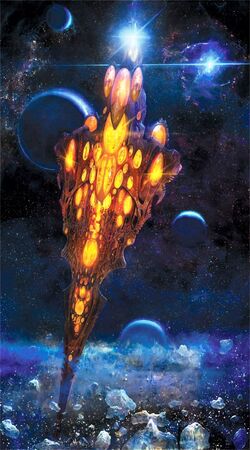
An Eldar Craftworld, dorsal view
In the aftermath of the Fall, the Aeldari, now calling themselves Eldar to mark their change from the greatness of old, regardless of faction, have faced a long and painful decline. On far-flung planets teeming with natural life, the Exodites have carved themselves a survivalist niche. Savage, primal places where everyday life was hard, these realms helped the Exodites to remain focussed on the ascetic lifestyle they had chosen. At first, many of their number fought and died against dangerous aliens such as the greenskinned Orks and even the soldiers of the nascent Imperium, but many others survived, reaching equilibrium and living in harmony with their adopted worlds. In the darkness of space, the remnants of the Eldar Empire cling onto what was left of their once-mighty culture, preserving the art and architecture of their people within the Craftworlds and passing their ancient history from generation to generation via song, dance and the recital of myths and parables. Aboard their continent-sized vessels, these fragments of the Eldar race sail the sea of stars, always seeking to stay one step ahead of She Who Thirsts and to somehow survive in a galaxy more hostile than ever.
The change that was wrought upon those Eldar sealed within the labyrinthine protections of the Webway was far more subtle. Rather than having their psychic essences, their souls, consumed in one great draught by Slaanesh, their souls slowly drained away into the Warp, taken over time by She Who Thirsts. The Eldar hate and fear Slaanesh above all other things, for she was given life by their actions and yet she waits hungrily to claim each and every one of them, now or later. Where the Eldar of the Craftworlds learned to deny Slaanesh's hold upon them by using the mystical Spirit Stones, the Infinity Circuits and the philosophies of the Eldar Paths to safeguard their souls from consumption by She Who Thirsts, the Eldar of the Webway became exceptionally good at ensuring that other beings suffered in their place. As long as they steeped themselves in the most evil and savagely decadent acts, the Eldar of the Webway found that the curse of Slaanesh upon their race could be avoided. The agony of others nourished their diminished souls and kept them vital and strong, filling their spare frames with unnaturally robust energies. Assuming that they could feed regularly enough upon the miseries of other intelligent beings, the Eldar of the Webway became psychically immune to the passage of time. So it was that the Dark Eldar were born, a race of sadistic murderers and torturers who feed upon the suffering of others in order to prevent the slow death of their own immortal souls. Ten thousand standard years later, in the 41st Millennium of Mankind, Slaanesh's Thirst consumes them still. There truly is no escape, for the Dark Eldar have only exchanged a horrible but quick death for an eternity of infernal hunger and the infinite emptiness wrought by self-absorption.
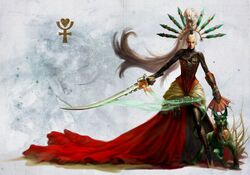
Yvraine, Daughter of Shades, Emissary of Ynnead, newborn Eldar God of the Dead, seeks to restore the Aeldari legacy
Cloistered deep within the hidden city-realms of the Webway, those survivors who concealed themselves in their palaces of depravity still revel in the debauched lifestyle that led to the Fall. In that twilight realm between the material universe and the Warp, the Dark Eldar mock and jeer those ravaged by the downfall of their race. Even though they would never admit it, they know in their hearts that, try as they might to allay their fate, Slaanesh will claim them in the end. The slow decline into powerlessness is what the Dark Eldar fear most of all, for in birthing Slaanesh from the endless tides of the Warp, the Eldar have created their greatest enemy. Slaanesh, in its dire awakening, has developed a taste for the souls of the Eldar. Where before, when an Eldar died, they would pass peacefully into the Warp in order to be reborn, now they face eternal torment, for Slaanesh has a perverse and twisted appetite that can never be sated. Unless extraordinary measures have been taken to prevent it, whenever an Eldar dies, Slaanesh will be waiting on the other side to consume him. She Who Thirsts will not rest until it has claimed every Eldar soul in the galaxy. The Eldar were doomed, and they know it well.
Only now, in the wake of the awakening of Ynnead, the Eldar God of the Dead in 999.M41, is their hope. Ynnead has chosen Yvraine, the Daughter of Shades, a child of both the Craftworlds and Commorragh, to be his prophet, the herald of a new dawn for the Eldar race. Calling themselves the Ynnari, the "Reborn," for the first time since the Fall, Eldar of all the known factions have begun to band together. Reliant upon the power of Ynnead to protect their souls from She Who Thirsts, the Ynnari have spoken of the restoration of the lost empire, and even dare to name themselves "Aeldari" once more...
Sources
- Codex Dark Eldar (5th Edition), pp. 5-13
- Codex: Dark Eldar (7th Edition) (Digital Edition), "Dark Origins"
- Codex: Eldar (3rd Edition), pp. 3-7
- Codex: Eldar (4th Edition), pp. 2-5
- Codex: Eldar (5th Edition), pp. 5-7
- Haemonculus Covens - A Codex: Dark Eldar Supplement (7th Edition) (Digital Edition),"The Chornicle of Endless Woe," pg. 118

